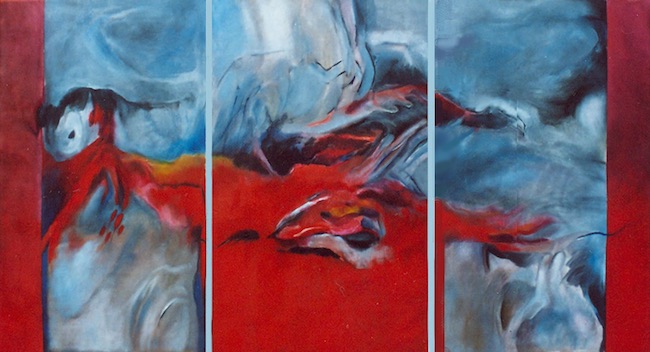Molto spesso lo sguardo artistico sulla realtà osservata ha la capacità di modificare e filtrare il visibile per assecondarlo alla soggettività dell’esecutore dell’opera, plasmarlo alla sua emozionalità senza che si conformi a ciò che lo sguardo coglie perché farlo significherebbe mettere in campo una razionalità limitante per la creatività; dunque i creativi che hanno questo approccio cercano in qualche modo di attrarre l’attenzione dell’osservatore con immagini che potrebbero vagamente essere associate all’oggettività reale ma poi, avvicinandosi per coglierne i dettagli, conducono verso un mondo più indefinito, improbabile, irreale, sollecitando l’attivarsi di un’interpretazione più profonda, legata a un’interiorità in grado di immaginare e di comprendere a un altro livello. L’artista di cui vi racconterò oggi sceglie esattamente questo tipo di stile pittorico per lasciar affiorare l’interpretazione del fruitore, come se l’arte fosse dunque un’esperienza interattiva tra il creatore e chi riceve le emozioni raccontate, nel suo caso, dai colori e dall’apporto grafico sempre presente.
Gli inizi del Ventesimo secolo furono un vero e proprio susseguirsi di innovazioni artistiche, di tentativi di lasciare indietro tutto ciò che aveva costituito regole e linee guida precedentemente ritenute irrinunciabili, con l’obiettivo di generare nuove realtà esecutive, inediti punti di vista sul modo di concretizzare l’impulso espressivo e di rimettere al centro del gesto plastico l’emozione, la soggettività dell’autore e la sua personale sensibilità interpretativa nei confronti dell’osservato. L’Espressionismo fu il primo, attraverso le intuizioni dei Fauves francesi, a mettere su tela questo moto di ribellione, questo desiderio di rinunciare all’equilibrio estetico, alla ricerca della perfezione realizzativa, alla prospettiva in grado di riprodurre l’idea della realtà, alle sfumature cromatiche e il chiaroscuro funzionali a raccontare con la massima precisione le luci e le ombre dei soggetti riprodotti; con l’Espressionismo tutto ciò non esisteva più perché la rilevanza era costituita dalle sensazioni dell’artista esecutore, dalle emozioni suscitate pensando od osservando una scena, e per riprodurre questo intenso sentire era consentito rinunciare persino alla bellezza, persino all’equilibrio formale e al contatto con la realtà. Le opere di Edvard Munch, di Ernst Ludwig Kirchner, di James Ensor, erano legate ai timori, alle insicurezze e alle debolezze dell’essere umano incapace di conformarsi all’ipocrita società borghese dell’epoca e dunque necessitanti di trovare un canale comunicativo che non poteva avere sfogo nella quotidianità, dunque l’arte era mezzo per far sentire la propria voce, a volte spaventata, a volte critica, altre semplicemente osservativa di ciò che era intorno. Nel periodo successivo alle guerre la fragilità e l’esiguità dell’uomo furono via via più evidenti e dunque la tendenza degli espressionisti divenne più intimista, come in Egon Schiele, oppure più sognante, come se la necessità fosse di evadere dall’oggettività, come in Marc Chagall. L’attitudine all’introspezione profonda che doveva manifestarsi anche nella pittura, e soprattutto la rinuncia alla forma estetica, vennero mantenute anche negli anni seguenti e in quegli artisti che raccolsero l’eredità dei pionieri dell’Espressionismo di inizio secolo adeguando però lo stile alla modernità dei tempi che stavano progredendo; fu proprio a Londra, rifugio per molti artisti che avevano dovuto lasciare i loro paesi a causa della seconda guerra mondiale, che operò una seconda generazione di espressionisti, quelli appartenenti alla Scuola di Londra e che vide in Lucian Freud l’interprete della debolezza umana e del suo essere indifeso davanti alle sofferenze emozionali, e in Francis Bacon il rappresentante della deformazione funzionale a suscitare emozioni connesse solo con l’anima. L’artista austriaca Monika Schönbacher-Frischenschlager adotta totalmente le linee guida dell’Espressionismo modificandole però secondo il suo sentire, o forse sarebbe meglio dire il suo filtro interpretativo che se da un lato conduce l’osservatore verso la dissoluzione della forma, dall’altro mostra l’esigenza di mantenere un contatto con una definitezza apparente, costituita da linee grafiche emergenti dalla mescolanza cromatica di cui si avvale per rappresentare un concetto, una sensazione o la narrazione personalizzata di qualcosa su cui la sua immaginazione e la sua interiorità hanno bisogno di riflettere.
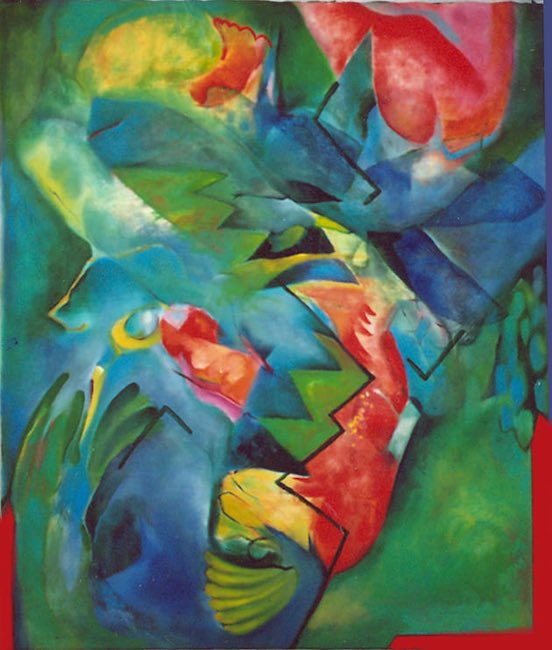
L’arte di Monika Schönbacher-Frischenschlager viene generata da un moto interiore, è questo il motivo per il quale sceglie di rinunciare a qualsiasi connessione con la realtà osservata per spostarsi verso la dimensione del percepire, quella in cui i particolari e i dettagli non contano poiché ciò su cui si deve focalizzare l’attenzione e la sensazione generale, l’insieme di vibrazioni che da essa si generano, è tutto ciò che si discosta dal dominio della razionalità.

Questo tipo di intento espressivo va alla sostanza, all’essenza di ciò di cui l’artista desidera parlare, crea una comunicazione diretta tra il soggetto esecutore, che imprime nell’opera tutto il suo sentire, e il soggetto osservante che invece riceve in modo inconsapevole un messaggio sublimato nella forma e diretto solo e unicamente alle profondità interiori e alla capacità di lasciarsi andare al dialogo con se stesso, alla riflessione e alla meditazione sui significati più elevati.

La tela Mutation è emblematica di questo concetto perché l’intuizione iniziale, sollecitata dal colore roseo del nucleo centrale, suggerisce alla ragione di interpretarla come un corpo umano, poi però, avvicinandosi all’opera si evidenzia una sorta di inconsistenza corporea, un’indefinitezza che se è vero che corrisponde allo stile esecutivo di Monika Schönbacher-Frischenschlager, lo è altrettanto che di conforma al suggerimento del titolo, incarnando una modificazione più immateriale che fisica. Sembra quasi essere un invito all’osservatore a guardare all’interno di sé, a comprendere tutto ciò che spesso non viene ascoltato ma che galleggia a livello inconscio fino ad aver bisogno di liberarsi dall’involucro che lo trattiene e poi liberarsi al fine di evolvere.
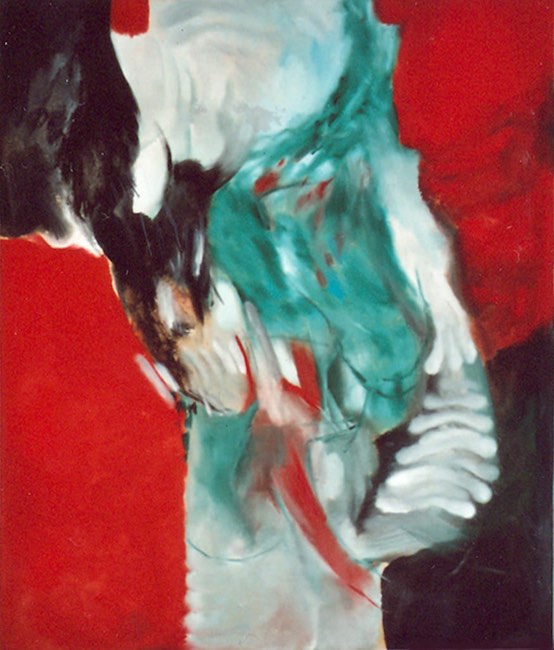
In Ohne Titel (Senza titolo) l’artista lascia libera facoltà ai colori di fluire sulla tela, senza dare alcuna indicazione sul suo moto creativo, perché a volte è necessario abbandonare ogni legame con la realtà per far sì che la mente liberi l’essenza permettendole di connettersi direttamente con tutto quel mondo interiore sommerso che spesso non trova la forza di affiorare in superficie; in questo caso invece tutto ciò che è necessario fare è porsi davanti all’opera ed entrare in diretta comunicazione con le tonalità scelte, lasciando che la propria natura, la fase dell’esistenza o semplicemente l’umore di quel preciso istante, diventino attori principali della simbiosi assoluta con il dipinto. Le emozioni suscitate dipendono dunque dal soggetto tanto quanto quelle emanate dall’autrice.
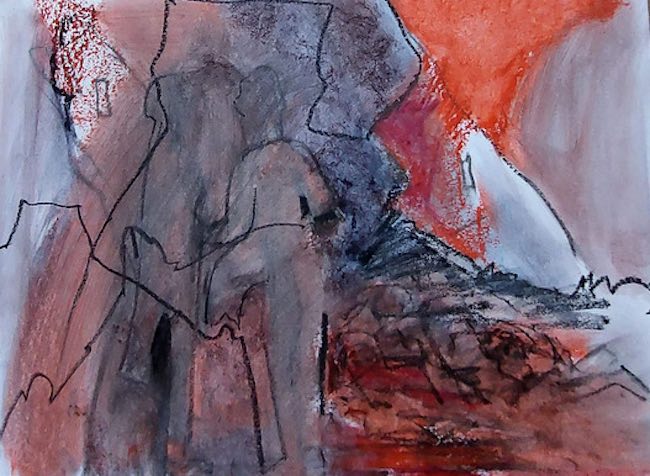
Alla produzione in olio su tela, Monika Schönbacher-Frischenschlager affianca anche opere realizzate in pastello a cera e trementina su supporto cartaceo, in cui esplora l’arte del passato reinterpretandola secondo il suo stile artistico e dove è molto più marcato l’apporto grafico, le linee scure che evidenziano ma anche nascondono l’immagine principale; il gioco tra realtà e sovrapposizione pittorica o grafica viene sottolineato per rendere più incisiva la trasformazione che ha subìto l’arte nel corso dei secoli, e nonostante ciò è riuscita a non tramontare mai anzi, i maestri di ieri hanno tracciato linee guida a cui gli artisti moderni e contemporanei, anche laddove hanno scelto di allontanarsi dall’armonia estetica e dalla riproduzione della realtà, non hanno potuto fare a meno di ispirarsi.
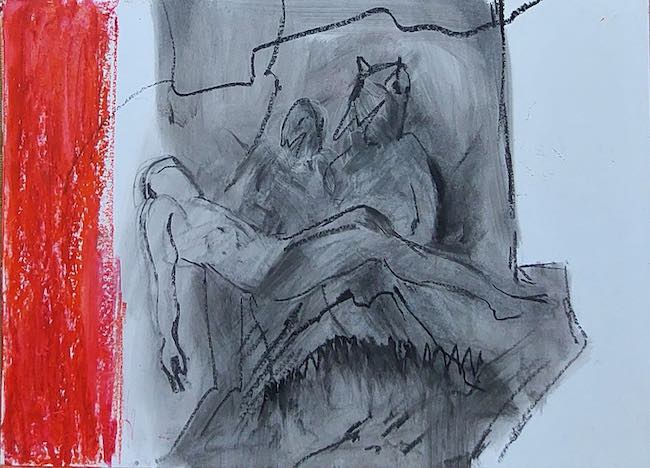
L’opera Pietà si rifà indiscutibilmente alla magnifica scultura di Michelangelo, reinterpretata da Monika Schönbacher-Frischenschlager con un tratto grafico predominante ma indefinito, introducendo non più la figura della Madonna bensì quella di due identità indecifrabili che vegliano la sofferenza del Cristo morente non con la medesima serenità dell’immagine originaria bensì con l’inquietudine dell’attesa del trapasso del corpo, enfatizzata dalla fascia laterale in rosso carminio sulla parte sinistra della composizione.
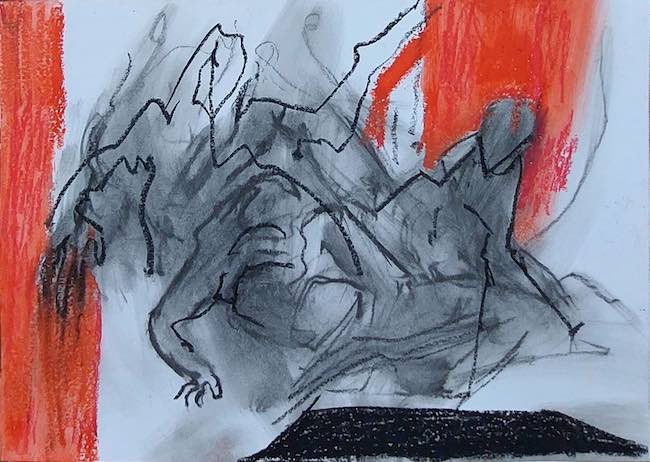
Monika Schönbacher-Frischenschlager, che ha una formazione come insegnante d’arte, si misura con cicli di opere, principalmente di grande formato, realizzate con diverse tecniche. Dal 1992 è membro permanente della Secessione di Graz, organizza simposi con artisti dalla Svezia all’Africa. Ha al suo attivo numerose mostre personali e collettive in gallerie e presso edifici istituzionali in Austria e all’estero – Bratislava, Berlino, Darmstadt, Leibzig, Bolzano, Firenze, Pharma, Lucerna, Atlanta (USA) -.
MONIKA SCHÖNBACHER-RISHCENSCHLAGER-CONTATTI
Email: monika@schoenbacher.at
Sito web: www.schoenbacher.at
Facebook: https://www.facebook.com/schoenbacherfrischenschlager
The Expressionism of Monika Schönbacher- Frischenschlager, between apparent realities and graphic superimpositions
Very often, the artistic gaze on the reality observed has the capacity to modify and filter the visible in order to accommodate the subjectivity of the artwork’s executor, moulding it to his emotionality without conforming to what the gaze grasps because to do so would mean bringing into play a rationality that would limit creativity; therefore, the creatives who take this approach somehow try to attract the observer’s attention with images that might vaguely be associated with real objectivity but then, as they get closer to grasp the details, lead to a more indefinite, improbable, unreal world, soliciting the activation of a deeper interpretation, linked to an interiority capable of imagining and understanding on another level. The artist I am going to tell you about today chooses exactly this type of painting style to allow the viewer’s interpretation to emerge, as if art were therefore an interactive experience between the creator and the person receiving the emotions told, in his case, by the colours and the ever-present graphic contribution.
The beginning of the 20th century was a veritable succession of artistic innovations, of attempts to leave behind everything that had constituted rules and guidelines previously considered inalienable, with the aim of generating new executive realities, new points of view on how to concretise the expressive impulse and to put emotion, the author’s subjectivity and his personal interpretative sensitivity towards the observed at the centre of the plastic gesture. Expressionism was the first, through the intuitions of the French Fauves, to put this movement of rebellion on canvas, this desire to renounce aesthetic balance, the search for perfection in execution, perspective capable of reproducing the idea of reality, the chromatic nuances and chiaroscuro functional to tell the story of the light and shadows of the subjects reproduced with the utmost precision; with Expressionism all this no longer existed because the relevance was the artist’s feelings, the emotions aroused by thinking or observing a scene, and to reproduce this intense feeling it was permissible to renounce even beauty, even formal balance and contact with reality. The artworks of Edvard Munch, Ernst Ludwig Kirchner, James Ensor, were linked to the fears, insecurities and weaknesses of the human being unable to conform to the hypocritical bourgeois society of the time and therefore in need of finding a channel of communication that could not be given vent in everyday life, so art was a means of making one’s voice heard, sometimes frightened, sometimes critical, sometimes simply observational of what was around. In the period after the wars, the fragility and meagreness of man became more and more evident and therefore the tendency of the expressionists became more intimist, as in Egon Schiele, or more dreamy, as if the need was to escape from objectivity, like in Marc Chagall.
The aptitude for profound introspection that had to manifest itself in painting, and above all the renunciation of aesthetic form, was maintained in the years that followed and in those artists who took up the legacy of the pioneers of Expressionism at the beginning of the century while adapting their style to the modernity of the times that were advancing; it was in London, a refuge for many artists who had had to leave their countries because of the Second World War, that a second generation of Expressionists worked, those belonging to the London School and who saw in Lucian Freud the interpreter of human weakness and helplessness in the face of emotional suffering, and in Francis Bacon the representative of functional deformation to arouse emotions connected only with the soul. The Austrian artist Monika Schönbacher-Frischenschlager totally adopts the guidelines of Expressionism, but modifies them according to her feelings, or perhaps it would be better to say her interpretative filter which, if on the one hand leads the observer towards the dissolution of form, on the other shows the need to maintain contact with an apparent definiteness, made up of graphic lines emerging from the chromatic mixture she uses to represent a concept, a sensation or the personalised narration of something her imagination and interiority need to reflect on. Monika Schönbacher-Frischenschlager‘s art is generated by an inner motion, which is why she chooses to renounce any connection with the observed reality and move towards the dimension of perception, the one in which details and particulars do not count since what one must focus on and the overall sensation, the set of vibrations generated by it, is everything that departs from the domain of rationality. This type of expressive intent goes to the substance, to the essence of what the artist wishes to talk about, it creates a direct communication between the subject executor, who imprints all his feeling into the artwork, and the observing subject who instead unconsciously receives a message sublimated in the form and directed only and exclusively to the inner depths and the ability to let himself go to dialogue with himself, to reflection and meditation on the highest meanings. The canvas Mutation is emblematic of this concept because the initial intuition, stimulated by the rosy colour of the central core, suggests to reason that it should be interpreted as a human body, but then, as one approaches the painting, a sort of corporeal inconsistency emerges, an indefiniteness that, if it is true that it corresponds to Monika Schönbacher-Frischenschlager’s style of execution, is equally true that it conforms to the suggestion of the title, embodying a modification that is more immaterial than physical.
It almost seems to be an invitation to the observer to look inside himself, to comprehend all that often goes unheard but floats at an unconscious level until it needs to free itself from the envelope that holds it back and then break free in order to evolve. In Ohne Titeln (Untitled), the artist allows the colours to flow freely on the canvas, without giving any indication of his creative motion, because sometimes it is necessary to abandon all ties with reality in order for the mind to free its essence, allowing it to connect directly with that whole submerged inner world that often does not find the strength to surface; in this case, instead, all one has to do is stand in front of the work and enter into direct communication with the chosen tones, letting one’s own nature, phase of existence or simply the mood of that precise moment, become the main actors of the absolute symbiosis with the painting. The emotions aroused thus depend as much on the subject as those emanating from the author. In addition to her oil on canvas production, Monika Schönbacher-Frischenschlager also produces artworks in wax pastel and turpentine on paper, in which she explores the art of the past by reinterpreting it according to her own artistic style and where the graphic contribution is much more pronounced, the dark lines highlighting but also concealing the main image; the interplay between reality and pictorial or graphic superimposition is emphasised in order to render more incisive the transformation that art has undergone over the centuries, and despite this, it has never waned; rather, the masters of yesterday drew guidelines from which modern and contemporary artists, even where they chose to depart from aesthetic harmony and the reproduction of reality, could not help but be inspired.
The artwork Pieta unquestionably refers to Michelangelo‘s magnificent sculpture, reinterpreted by Monika Schönbacher-Frischenschlager with a predominant but indefinite graphic stroke, introducing no longer the figure of the Madonna but that of two indecipherable identities who watch over the suffering of the dying Christ, not with the same serenity as the original image but with the restlessness of waiting for the passing of the body, emphasised by the carmine red side band on the left side of the composition. Monika Schönbacher-Frischenschlager, who trained as an art teacher, measures herself with cycles of artworks, mainly large-format, made with different techniques. Since 1992 she has been a permanent member of the Graz Secession, organising symposia with artists from Sweden to Africa. She has numerous solo and group exhibitions in galleries and institutional buildings in Austria and abroad – Bratislava, Berlin, Darmstadt, Leibzig, Bolzano, Florence, Pharma, Lucerne, Atlanta (USA) – to her credit.


